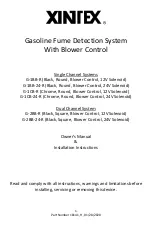
© 2020 Radiodetection Ltd
11
Section 4 - Operation
4.1 First use
Power options
RD8200 systems are shipped as standard configured to
use D cell alkaline batteries.
Both the locator and transmitter can also be powered
using good quality rechargeable D-cell NiMH batteries or
the optional accessory Li-Ion rechargeable battery
packs.
It’s important to set the correct battery chemistry
in the locator to optimize performance, see Section 4.5
Transmitters can also be powered using optional
accessory mains or vehicle power adapters. Refer to
section 13.15 for more information.
Inserting batteries
RD8200 systems are shipped with D cell battery trays.
Suitable alkaline or NiMH batteries should be fitted in the
battery compartment before your first use.
On the Locator:
To fit the D-cell batteries in the locator, unlatch the
battery compartment
Figure 4.1 Open the battery compartment
Insert 2 × good quality D-cell batteries. Note the polarity
of the cells when inserting them in the battery tray.
Figure 4.2 Inserting locator batteries
On the transmitter:
To fit the D-cell batteries in the transmitter, unlatch the
accessory tray. The battery compartment (see figure
3.2) is located underneath the transmitter body. Use the
turnkey to unlatch the battery compartment. Insert eight
D-Cell Alkaline or NiMH batteries.
Figure 4.3 D-cell battery trays
Battery status
The locator and transmitter displays provide a battery
level indicator (refer to the diagrams in Section 3). When
battery replacement is necessary, the display shows a
flashing battery icon.
NOTE: Prolonged use of maximum volume and vibration
alerts on the locator will reduce battery life.
NOTE: Prolonged use of high power output on the
transmitter will reduce battery life.
Removing / fitting battery packs
Locator battery pack:
1 Open the battery compartment using the release
catch (figure 4.1)















































